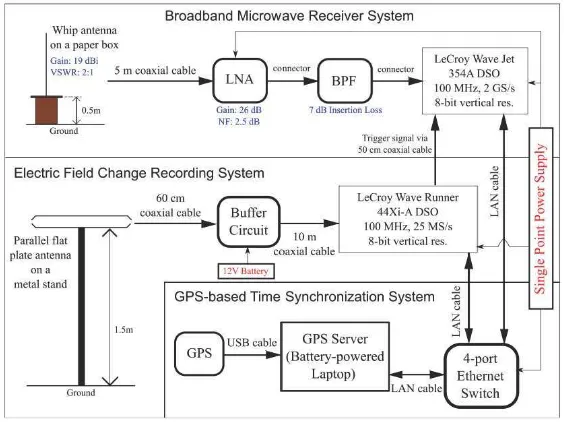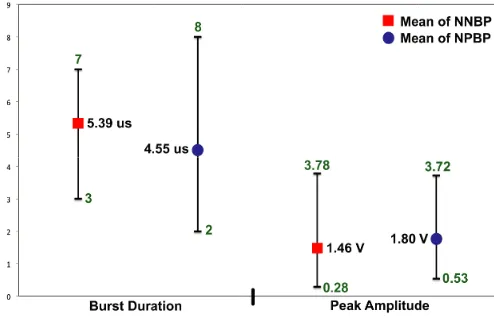Progress In Electromagnetics Research Symposium Proceedings, Stockholm, Sweden, Aug. 12-15, 20131087
Narrow Bipolar Pulses and Associated Microwave Radiation
M. R. Ahmad1,3, M. R. Mohd Esa2,3,and V. Cooray3
Department of Engineering Science, Uppsala University, Sweden
Abstract— Narrow Bipolar Pulses (NBPs) is a special type of intra-cloud lightning discharge activities and was observed with both polarities: negative (NNBP) and positive (NPBP). It is known with other names also such as Narrow Bipolar Events (NBEs), energetic intracloud events, and Compact Intracloud Discharges (CIDs). NBP signatures have been measured by using various methods such as electric field change recording systems, HF-VHF direct measurement systems (filter-detector receiver), and satellite-based systems. To the best of our knowledge, there are no attempts have been made to measure NBP signatures at microwave region so far. In this paper, observations of microwave radiation from thunderstorms have been made during the northeastern monsoon season of 2012 in Malaysia. Fast electric field change recording and broadband microwave receiver systems have captured simultaneous records of NBPs electric field change and microwave radiation, respectively. Strong noise-like burst of microwave radiation pulses associated with NBP events were detected. The total duration of the microwave bursts of the pulses is in the range between 2 and 8µs for both NNBPs and NPBPs. More than 70% of the recorded radiation bursts arrived a few microseconds before the onset of the corresponding NBPs. The analyzed temporal characteristics of the microwave radiation bursts for both NNBPs and NPBPs are similar and indistinctive. In contrast, the analyzed NNBPs and NPBPs temporal characteristics are distinctive to some extent.
1. INTRODUCTION
Previous studies on narrow bipolar pulses (NBPs) have been concentrated on the associated HF and VHF radiations only. Le Vine [2] reported observations of narrow positive bipolar pulses (NPBPs) at 3 MHz, 139 MHz, and 295 MHz using vertically polarized antennas. They observed that NPBP produced the strongest RF radiation and even larger than RF radiation of return strokes at these HF and VHF frequencies. Rison, et al. [3] reported observations of narrow negative bipolar pulses (NNBPs) at 63 MHz. They observed that the peak VHF radiation of NNBP was 30 dB greater than IC and CG events. Smith, et al. [5] reported observations of NPBPs recorded by broadband HF systems between 3 to 30 MHz using discone antennas. The broadband noise-like HF radiation bursts associated with NPBPs has a mean duration of 2.8µs and amplitudes ten times larger than
radiation from IC and CG discharges at HF frequencies. Sharma, et al. [4] reported observations of NPBPs at 5 and 10 MHz using parallel flat plate antennas. They observed that these HF radiations start with the onset of the NPBP event. Ahmad, et al. [1] reported observations of both NPBPs and NNBPs at 3 MHz and 30 MHz using parallel flat plate antennas. They found that nano-scale fine and sharp pulses embedded on the micro-scale NBP pulses. The overall duration of a nano-scale pulse is in the range between a few nanoseconds and 20 nanoseconds. These nano-nano-scale pulses always trigger the 3 and 30 MHz narrowband receivers. These nano-scale pulses could be associated with the observed microwave radiation pulses presented in this paper.
In this paper, observations of microwave radiation bursts of pulses emitted during NBP event are reported for the first time. Both types of NBPs (NPBP and NNBP) are accompanied by the microwave radiation bursts and detail analysis of the time behavior between them is provided. The initial polarity of NBP is defined according to the atmospheric sign convention throughout the paper.
2. EXPERIMENTATION
The measurements were conducted between November and December 2012 during the northeast monsoon period at Observatory Station in Universiti Teknologi Malaysia (UTM), Johor, Malaysia, located at southern part of peninsular Malaysia (1◦N, 103◦E). The measuring system was situated
1088 PIERS Proceedings, Stockholm, Sweden, Aug. 12–15, 2013
recording system was used to record fast variation of the vertical electric field change while the broadband microwave receiver system was used to capture microwave radiations associated with the recorded fast electric field change waveforms. A GPS timing server was used to maintain accurate clock synchronization of the digital storage oscilloscopes (DSOs) between the two systems. The broadband microwave receiver system consisted a Low Noise Amplifier (LNA) connected to a Band Pass Filter (BPF) with operating frequencies between 1.5 and 3 GHz. Electrical signals induced by the incident electric fields on a whip antenna with omni directional pattern (E-plane half power beam width 19 degrees and 9 dBi gain) were directed towards the LNA by using a 5 meters 50 Ω RG58 coaxial cable. The output electrical signals of the BPF were digitized directly by a DSO at a rate of 2.5 Giga Samples/second. A DSO at a rate of 25 Mega Samples/second digitized the output of electrical signals from the fast electric field change recording system.
Figure 1: Diagram of the observational instruments consisting three systems to measure NBPs and its associated microwave radiations.
3. RESULTS AND DISCUSSION
A total number of 64 NBPs was analyzed where 58.7% of them were NNBPs and the others were NPBPs, which in good agreement with Ahmad, et al. [1] observation. Examples of NNBP and NPBP and their associated microwave radiation noise-like bursts are shown in Fig. 2 and Fig. 3, respectively. More than 70% of the observed microwave radiation bursts were recorded before the onset of their corresponding NBPs.
The pulse duration of NNBPs is varied between 9.5 and 90.46µs with the mean value of 25.3±
(a)
(b)
Progress In Electromagnetics Research Symposium Proceedings, Stockholm, Sweden, Aug. 12-15, 20131089
(a)
(b)
Figure 3: (a) A record of NPBP and (b) its associated noise-like microwave radiation burst.
19.8, which in good agreement to the duration obtained by Ahmad, et al. [1]. On the other hand, the pulse duration of NPBPs has shorter range and smaller mean values, varied between 5.6 and 25.5µs with the mean value of 13.4±7.5, which in good agreement with the recorded mean value by
Le Vine [2], and Sharma, et al. [4]. The statistical distribution of zero crossing time (ZCT), rise time,
Figure 4: Statistical distribution of temporal characteristics for both NNBP and NPBP recorded from the fast electric field change recording system.
1090 PIERS Proceedings, Stockholm, Sweden, Aug. 12–15, 2013
full width at half maximum (FWHM), and the ratio of initial peak to the overshoot peak (Pa/Os)
is plotted in Fig. 4 and comparable to the statistical distribution obtained by Sharma, et al. [4] and Ahmad, et al. [1]. The statistical distribution of the microwave radiation burst duration and peak amplitude is plotted in Fig. 5. The values of the burst duration for both NNBP and NPBP are almost 2 times higher than the value recorded by Smith, et al. [5] from broadband HF system.
4. CONCLUSIONS
Microwave radiation in the form of noise-like bursts was detected with more than 70% of the recorded radiation bursts has arrived a few microseconds before the onset of the corresponding NBPs. The analyzed temporal characteristics of the microwave radiation bursts for both NNBPs and NPBPs are similar and indistinctive. In contrast, the analyzed NNBPs and NPBPs temporal characteristics are distinctive to some extent.
ACKNOWLEDGMENT
The authors would like to thank IVAT lightning research team for their support in conducting the experimental work in UTM, Malaysia.
REFERENCES
1. Ahmad, H. and Z. A. Malek, “Characteristics of narrow bipolar pulses observed in Malaysia,”
Journal of Atmospheric and Solar-terrestrial Physics, Vol. 72, 534–540, 2010.
2. Le Vine, D. M., “Sources of the strongest lightning radiation from lightning,” Journal of Geophysical Research, Vol. 85, No. C7, 4091–4095, 1987.
3. Rison, W., R. J. Thomas, P. R. Krehbiel, T. Hamlin, and J. Harlin, “A GPS-based three di-mensional lightning mapping system: Initial observations in central new Mexico,”Geophysical Research Letter, Vol. 26, No. 23, 3573–3576, 1999.
4. Sharma, S. R., M. Fernando, and V. Cooray, “Narrow positive bipolar radiation from lightning observed in SRI Lanka,”Journal of Atmospheric and Solar-terrestrial Physics, Vol. 70, 1251– 1260, 2008.

